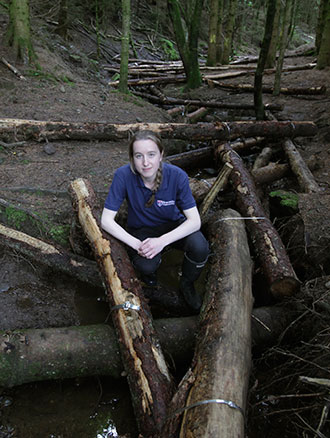August
‘Kerplunk’ system slows the flow

A runoff and water quality project inspired by the childhood game Kerplunk is being used to slow the flow of water, reduce flood risk and improve water quality in a Northumberland river.
Led by Tyne Rivers Trust, and part of a larger Defra and Environment Agency funded project focusing on water quality across the whole burn, the Slaty Sike development stems from research being carried out by Newcastle University. It was developed in response to ongoing problems around a build-up of sediment in Haltwhistle Burn.
Consisting of a 60m ‘ladder’ of criss-crossing logs carefully pinned into the banks of Slaty Sike, a tributary of the burn, the aim is to slow the flow of water during periods of intense rainfall, trapping sediments and rocks just like the marbles in a game of Kerplunk.
At the top of the ladder are four ponds – the first line of defence – which help to hold back the water, reducing the risk of flooding in the town and the erosion of the catchment.
Eleanor Starkey (pictured), a PhD student at Newcastle University who is responsible for monitoring the impact of the system, along with the local River Watch group, explains: “The UK has seen an increase in the number of extreme weather events over the past decade and at Newcastle University we are working on a number of Natural Flood Management schemes to help our environment cope with this changing climate.
“Slaty Sike is a good example of a catchment that copes well under normal weather conditions but when the area is hit by bigger storms we see a rapid flow of water down the catchment, washing debris and stones into the Burn.
“The aim of this new system is to slow that flow and hold back the debris, improving water quality lower down and also reducing the risk of flash flooding in the town which can be caused by the build-up of large debris, particularly under bridges.”
Employing horses rather than machinery
Funded by Defra and the Environment Agency, the wider Haltwhistle project has involved a wide range of people from the local community – including landowners, the volunteer-led Haltwhistle Burn River Watch group, Northumberland National Park, Haltwhistle Town Council, local business owners and schoolchildren – as well as calling on the expertise of Newcastle University.
Installed in June, it is the largest system of its kind in the UK and was designed by Dr Paul Quinn, Senior Lecturer in Catchment Hydrology at Newcastle University, and built by Ian Benson of Ian Benson Design and Build.
In order to get the timber to the challenging site the Tyne Rivers Trust used horsepower. Jimmy the Horse, owned by Amber Horse Logging, hauled around 10 tonnes of timber through steep fields to the edge of the burn.
The next step is to monitor its effectiveness and understand more about how it will need managing in the long term and whether it can be rolled out to other parts of the country. Members of the River Watch group have already been trained by Eleanor to monitor rainfall, river levels, water quality and flood events. It is hoped that their involvement will continue beyond the lifetime of the project and help to monitor the new system.
Susan Mackirdy, Director of Tyne Rivers Trust, said: “Slaty Sike is a great example of the importance of river management features to both water quality improvements and natural flood risk management.
“It is part of much larger project for us, which has been ongoing for over two years on the Haltwhistle Burn. This is an area of great importance to the community, and the river is used by many people for leisure activities.
“More importantly, the project highlights the importance of partnership working at its best, community involvement and what can be achieved when organisations work together to share information and expertise.”
published on: 28 August 2015
